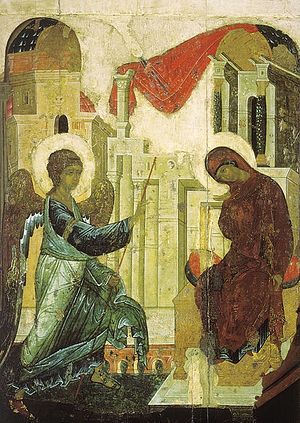The feast of the Annunciation of the Virgin Mary comes nine months before Christmas on the twenty-fifth of March. It is the celebration of the announcing of the birth of Christ to the Virgin Mary as recorded in the Gospel of Saint Luke.
In the sixth month the angel Gabriel was sent from God to a city of Galilee named Nazareth, to a virgin betrothed to a man whose name was Joseph, of the house of David; and the virgin’s name was Mary. And he came to her and said, “Hail, full of grace, the Lord is with you!” But she was greatly troubled at the saying, and considered in her mind what sort of greeting this might be. And the angel said to her, “Do not be afraid, Mary, for you have found favor with God. And behold, you will conceive in your womb and bear a son, and you shall call his name Jesus. He will be great, and will be called the Son of the Most High; and the Lord God will give to him the throne of his father David, and he will reign over the house of Jacob forever; and of his kingdom there will be no end.” And Mary said to the angel, “How can this be, since I have no husband?” And the angel said to her, “The Holy Spirit will come upon you, and the power of the Most High will overshadow you; therefore the child to be born will be called holy, the Son of God. And behold, your kinswoman Elizabeth in her old age has also conceived a son, and this is the sixth month with her who was called barren. For with God nothing will be impossible.” And Mary said, “Behold, I am the handmaid of the Lord; let it be to me according to your word.” And the angel departed from her (Lk 1:26-38).
The services of the feast of the Annunciation, the Matins and the Divine Liturgy, stress again and again the joyous news of the salvation of men in the birth of the Saviour.
Today is the beginning of our salvation, the revelation of the eternal mystery. The Son of God becomes the Son of the virgin, as Gabriel announces the coming of Grace. Together with him let us cry to the Theotokos: Rejoice, O Full of Grace, the Lord is with you (Troparion).
A special feature of this feast is the Matinal Canon which has the character of a dialogue between the Archangel Gabriel and the Virgin Mary. Also among the more popular elements of the feast is the Magnification which has the form of our own salutation to the virgin mother with the words of the archangel:
With the voice of the archangel we cry to Thee, O Pure
One: Rejoice, O Full of Grace, the Lord is with Thee!
(Magnification).
The celebration of the Annunciation, therefore, is the
feast of our own reception of the glad tidings of
salvation, and our own glorification of the maiden Mary
who becomes the Mother of God in the flesh.
Because the feast of the Annunciation normally comes during the season of Great Lent, the manner of celebration varies from year to year depending upon the particular day on which it falls. If the feast comes on a weekday of Lent, which is the most common case, the Divine Liturgy of the feast is served in the evening with Vespers and thus is celebrated after a full day of total abstinence. When this happens, the fasting rules for the Liturgy of the Presanctified Gifts are followed. The Divine Liturgy of the Annunciation is the only celebration of the eucharistic liturgy of Saint John Chrysostom allowed on a weekday of Great Lent.

